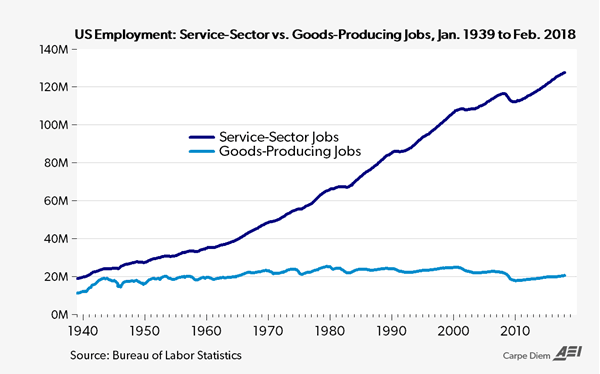The chart below shows that the number of goods-producing jobs in the US has remained relatively flat since WWII at about 20 million, while the number of service-sector jobs has increased nearly seven-fold during that time period from fewer than 19 million in 1939 to nearly 128 million in February 2018. And yet, for several generations, we seem determined as a country to try to save or bring back manufacturing/factory jobs that never really existed at levels very far above today’s level for goods-producing employment. At the same time, there’s not much attention paid to promoting or celebrating the service sector, which is really America’s only job-creating sector that has added an average of 1.62 million jobs annually (81 million jobs in total) over the last half-century, while the goods-producing sector shed 1.8 million jobs.
That issue and paradox were discussed in two recent articles featured below.
1. From the New York Times article “Most Americans Produce Services, Not Stuff. Trump Ignores That in Talking About Trade” by Neil Irwin:
You probably work in the service sector. This seems like a safe assertion, as 86 percent of private-sector jobs in the United States are in services. By contrast, “goods-producing” jobs like logging, mining, construction, and manufacturing accounted for only 20.5 million jobs last month, in a nation with 148 million total positions (see chart above).
If we’ve guessed right about your occupation, the question for you and 128 million fellow service workers—a very broad category that includes retail clerks, truck drivers, architects, bankers, doctors and more—is whether the Trump administration cares about your economic fate.
The most recent reason to wonder is President Trump’s repeated assertion this week that the United States maintains a trade deficit with Canada—a claim contradicted by United States government data. Mr. Trump’s spokeswoman, Sarah Huckabee Sanders, said in a Twitter message that numbers showing a trade deficit with the country “reflect trade in goods.” In other words, it’s true the United States runs a trade deficit with Canada as long as you don’t include service industries—the industries that account for the vast majority of jobs.
….
The risk is that if trade negotiators follow the president’s lead and focus entirely on obtaining more advantageous treatment for American goods-producing industries, it could come at the cost of concessions that damage industries that employ far more people.
……
…for that great majority of people who work in service industries, it might be reassuring if the president himself acknowledged more readily that there’s more to a modern economy than making physical stuff.
2. From the article “America’s Strength in Services Promises Trade Success” by John G. Murphy,
George Orwell famously wrote that “to see what is in front of one’s nose needs a constant struggle.” This statement is certainly true for the vast and often overlooked world of trade in services. Consider:
- Services Rule. Services dominate the U.S. economy. Broadly speaking, services provide about 80% of all American jobs (approximately 120 million of 150 million American jobs, according to data from the Bureau of Labor Statistics, see chart above).
- More Jobs, Higher Pay. Professional and business services employ 20.5 million Americans, making this sector a larger employer than manufacturing (66% larger, in fact). What’s more, these are good jobs: Wages in these fields are 18% higher on average than those in manufacturing (average hourly earnings of $31 versus $26).
- Increasingly Tradeable. Many services can be exported, particularly those categorized broadly as professional and business services. These include fields such as audiovisual, software, architecture, accounting, engineering and project management, banking, insurance, waste management, and advertising. The Internet is making more of these services tradeable every day.
- Competitive Advantage. The United States has become the world’s largest exporter of services. U.S. services exports reached $750 billion in 2016, and the United States has a trade surplus in services of $248 billion. What’s more, services sales by foreign affiliates of U.S. multinational corporations top $1.4 trillion.
- Untapped Potential. Despite these big numbers, the potential for service industries to engage in international trade is almost untapped. One in four U.S. factory exports, but just one in every 20 providers of business services does so. Just 3% of U.S. services output is exported, according to the Peterson Institute for International Economics.
Clearly, a trade agenda that focuses exclusively on manufacturing and agriculture would leave money on the table. To capitalize on America’s tremendous strengths in services, the Trump Administration should jumpstart the Trade in Services Agreement (TISA) negotiations.
The TISA aims to remove barriers to trade in services among 50 countries that represent more than two-thirds of world trade in services. When the TISA negotiations began three years ago, the Chamber and other business groups advised that its chief goals should be to expand access to foreign markets and bar discrimination against U.S. companies. In addition, it should lift foreign governments’ limits on U.S. investments in their services sectors.
The TISA also represents an opportunity to craft enforceable rade rules that reflect how data has become the new currency of international commerce. That’s why the TISA must include enforceable rules to ensure that enterprises and individuals can move data across borders in a reliable and secure manner.
To illustrate the point, a recent Chamber study estimated that reducing market and regulatory barriers to cross-border information and communications technology (ICT) services could boost global GDP by an impressive $1.72 trillion. This finding confirms that international data flows have become a vital catalyst of global economic growth—and American companies and American technology are at the forefront.
The TISA is a great opportunity for the United States to go on offense. It’s a major opportunity to spur U.S. economic growth and job creation. The United States needs to be at the table, setting the rules of trade, and reaping the rewards.
It’s a great point that all of the incessant hand-wringing about the loss of US factory jobs, the decline of the Rust Belt, and the supposed “hollowing out of American manufacturing,” and the subsequent attempts to save or bring back those jobs with protectionist trade policy, miss the bigger picture of the US labor market, which is a job-creating machine when it comes to the dynamic, thriving service-providing sector that has added an average of 4,500 new jobs every day to the nation’s labor force over the last half-century.
Reprinted from the American Enterprise Institute.

Mark J. Perry
Mark J. Perry is a scholar at the American Enterprise Institute and a professor of economics and finance at the University of Michigan’s Flint campus.
This article was originally published on FEE.org. Read the original article.
![]()






